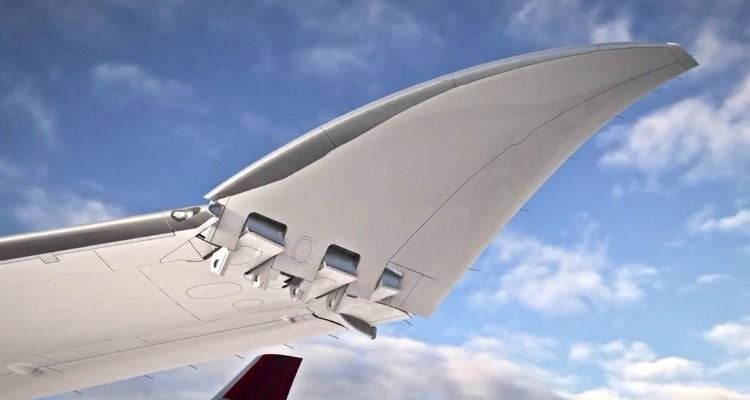Boeing credits much of the 777X’s improved fuel efficiency to the aircraft’s composite wings, which stretch 71.8m (236ft) from wingtip to wingtip. To make sure that the 777X will fit in existing airport gates, the wingtips will be able to fold upward by 3.5m on each side.
Liebherr-Aerospace has been selected to design, develop, and manufacture the folding wing tip system. With its motor and rotating actuator, this system will fold the wing tip after landing, thus reducing the wingspan of the new wide-body aircraft by 7 meters. The folding wingtip system is the first of its kind in commercial aviation, so extensive testing is required. Not only to ensure passenger convenience (passengers should actually not hear loud noises or significantly feel the action of the mechanics), but also from a safety perspective. Failures or external threats must not compromise both primary and backup systems simultaneously. A wingtip failure will ground the aircraft!
For this critical test program Liebherr-Aerospace uses a Gantner Instruments Q.series system to perform the primary data acquisition tasks. The flexibility of the Q.series system, in combination with a wide variety of commercial off-the-shelf I/O modules, allows Liebherr-Aerospace to maximize test equipment utilization, test bench availability and overall test lab performance. On top of that, the Q.series measurement system features a set of specific features that are crucial for successful aircraft component testing. So does the Q.series system come with precise nanosecond time synchronization between all modules and to external time references, eliminating the uncertainty of data skew during critical test conditions.
The build-in test automation functionality enables quick and efficient monitoring and processing of measurement data, minimizing manual system handling and shortening overall test duration time. And last but not least, the Q.series system has 3 levels of redundancy for assured data availability. Measurement data can be transferred to 2 data storage locations simultaneously and 1 data location for backup.
More Information
Click here to receive a personalized Application Example Pack containing the real-world application example “Boeing 777X Folding Wingtip System Test” and a few bonus application examples within the Aerospace industry!
More articles
Putting Intelligent Heat Pump Control to the Test Real World Performance Evaluation
Given the increasing share of renewable energies in the electric energy system, flexibilities are key to match production and demand. Domestic heat pumps are expected and promoted to further increase as a key technology. Research is ongoing to utilize these heat pump systems and their thermal storage as flexibilities within the electrical energy system’s superordinate level.
Read more...China International Battery Fair 2023
The path to reduced battery test bench development cycles, more accuracy, and better high voltage isolation starts with Gantner Instruments at China International Battery Fair in Shenzhen, China, from May.16 to May.18, 2023.
Read more...Introducing the Q.series X A12x 1500V Plus Versions
Gantner Instruments expanded the A12x module lineup with Plus versions (e.g., Q.series X A128 Plus SEB) that feature an increase in their voltage capacity up to 1500V, meeting the evolving demands of industries that require higher voltage limits for testing and measurement. Let's delve deeper into the enhanced capabilities of the A12x module lineup and how they empower engineers across various industries.
Read more...Bridge Excitation and Measuring Range with Strain Gauge
Strain gauge bridges provide signals that depends on bridge excitation. Therefor the bridge signal is expressed in mV/V (ratiometric measurement).
Read more...